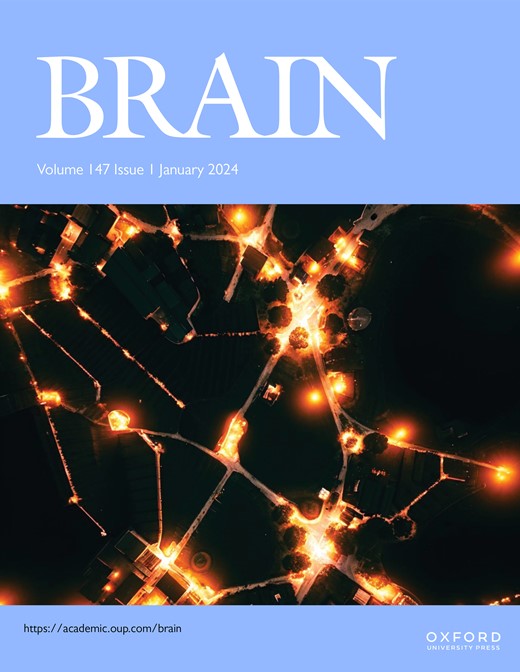Perivascular space dysfunction in cerebral small vessel disease is related to neuroinflammation
IF 10.6
1区 医学
Q1 CLINICAL NEUROLOGY
引用次数: 0
Abstract
Enlarged perivascular spaces are a feature of cerebral small vessel disease, and it has been hypothesized that they may reflect impaired glymphatic drainage. The mechanisms underlying perivascular spaces enlargement are not fully understood, but both increased inflammation and blood brain barrier permeability have been hypothesized to play a role. We investigated the relationship between perivascular spaces and both CNS and peripheral inflammation, as well as blood brain barrier permeability, in cerebral small vessel disease. Fifty-four symptomatic sporadic cerebral small vessel disease patients were studied. perivascular spaces were quantified using both a visual rating scale, and by measurement of perivascular spaces volume, in both the white matter and basal ganglia. PET-MRI was used to simultaneously measure microglial activation using the radioligand 11C-PK11195, and blood brain barrier permeability was acquired using dynamic contrast enhanced MRI. We determined 11C-PK11195 binding and blood brain barrier permeability in the local vicinity of individual perivascular spaces in concentric shells surrounding perivascular spaces. In addition, both mean 11C-PK11195 binding and blood brain barrier permeability in both the white matter and basal ganglia were determined. To assess systemic inflammation a panel of 93 blood biomarkers relating to cardiovascular disease, inflammation and endothelial activation were measured. Within the white matter tissue in closest proximity to perivascular spaces displayed greater 11C-PK11195 binding (p < 0.001), in the vicinity of perivascular spaces. Higher white matter perivascular spaces burden on the visual rating scale was associated with higher white matter 11C-PK11195 binding (rho = 0.469, FDR-p =0.009); values for perivascular spaces volume showed a similar trend. In contrast there were no associations between basal ganglia perivascular spaces burden and 11C-PK11195 binding. No perivascular spaces marker correlated with blood brain barrier permeability. There was no association between perivascular spaces markers and systemic inflammation blood biomarkers. Our findings demonstrate that white matter perivascular spaces are associated with increased 11C-PK11195 binding, consistent with neuroinflammation playing a role in white matter perivascular spaces enlargement. Further longitudinal and intervention studies and required to determine whether the relationship between neuroinflammation with enlarged perivascular spaces is causal.脑小血管疾病的血管周围间隙功能障碍与神经炎症有关
血管周围间隙增大是脑小血管疾病的一个特征,据推测,这可能反映了甘液引流功能受损。血管周围间隙扩大的机制尚未完全明了,但有假设称炎症和血脑屏障通透性增加在其中发挥了作用。我们研究了脑小血管疾病中血管周围间隙与中枢神经系统和外周炎症以及血脑屏障通透性之间的关系。我们对 54 名有症状的散发性脑小血管病患者进行了研究。使用视觉评分量表和测量白质和基底节的血管周围空间体积对血管周围空间进行了量化。PET-MRI 利用放射性配体 11C-PK11195 同时测量小胶质细胞的活化情况,并利用动态对比增强 MRI 获取血脑屏障的通透性。我们测定了单个血管周围间隙周围同心壳局部附近的 11C-PK11195 结合率和血脑屏障通透性。此外,我们还测定了白质和基底节的平均 11C-PK11195 结合率和血脑屏障通透性。为了评估全身炎症,测量了与心血管疾病、炎症和内皮活化有关的 93 种血液生物标记物。在最接近血管周围空隙的白质组织内,血管周围空隙附近的 11C-PK11195 结合率较高(p &;lt;0.001)。在视觉评分量表中,白质血管周围间隙负担越重,白质 11C-PK11195 结合率越高(rho = 0.469,FDR-p =0.009);血管周围间隙体积值也呈现类似趋势。与此相反,基底节血管周围空间负担与 11C-PK11195 结合力之间没有关联。没有一种血管周围间隙标记物与血脑屏障通透性相关。血管周围空隙标记物与全身炎症血液生物标记物之间没有关联。我们的研究结果表明,白质血管周围空隙与 11C-PK11195 结合力增加有关,这与神经炎症在白质血管周围空隙扩大中的作用一致。需要进一步开展纵向和干预研究,以确定神经炎症与血管周围间隙扩大之间是否存在因果关系。
本文章由计算机程序翻译,如有差异,请以英文原文为准。
求助全文
约1分钟内获得全文
求助全文
来源期刊

Brain
医学-临床神经学
CiteScore
20.30
自引率
4.10%
发文量
458
审稿时长
3-6 weeks
期刊介绍:
Brain, a journal focused on clinical neurology and translational neuroscience, has been publishing landmark papers since 1878. The journal aims to expand its scope by including studies that shed light on disease mechanisms and conducting innovative clinical trials for brain disorders. With a wide range of topics covered, the Editorial Board represents the international readership and diverse coverage of the journal. Accepted articles are promptly posted online, typically within a few weeks of acceptance. As of 2022, Brain holds an impressive impact factor of 14.5, according to the Journal Citation Reports.
 求助内容:
求助内容: 应助结果提醒方式:
应助结果提醒方式:


